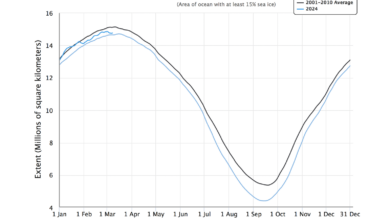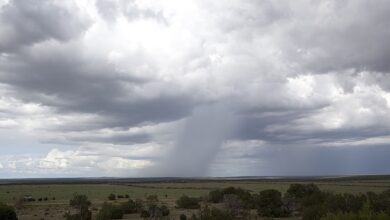The Deadly Geo-engineering Idea which Refuses to Die • Watts Up With That?

Essay by Eric Worrall
Greens seem to have an obsession with dimming the sun, otherwise known as starving plants of sunlight and stripping away our disease resistance.
Why dimming the Sun would be an effective tool in the fight against climate change
Published: December 7, 2023 2.53am AEDT
Peter Irvine
Lecturer in Earth Sciences, UCLIt’s becoming increasingly clear that we will fail to meet our climate goals. We were already at 1.26°C of warming in 2022 and are on track to blow through 1.5°C in the mid-2030s. Research even suggests that current climate policy will lead to more than 2.5°C of warming by the end of this century.
Warming of this magnitude would devastate vulnerable communities and ecosystems around the world. It’s time we consider something radically new that could stop climate change in its tracks.
After powerful volcanic eruptions, like Tambora (Indonesia) in 1815 and Pinatubo (Philippines) in 1991, global temperatures dipfor a few years. Major eruptions create a hazy layer of microscopic particles in the upper atmosphere that last for several years, dimming the Sun temporarily. We could copy this effect to fight climate change.
…
I don’t get how educated people can convince themselves deliberately dimming the sun is a good idea, when there is an abundance of evidence that it would be a very bad idea.
Last time the sun was dimmed significantly by a series of major volcanic eruptions, the Eastern Roman Empire almost failed. The dimming of the sun during the dark ages had multiple severe adverse consequences for human health.
Volcanic dust veils from sixth century tree-ring isotopes linked to reduced irradiance, primary production and human health
Samuli Helama, Laura Arppe, Joonas Uusitalo, Jari Holopainen, Hanna M. Mäkelä, Harri Mäkinen, Kari Mielikäinen, Pekka Nöjd, Raimo Sutinen, Jussi-Pekka Taavitsainen, Mauri Timonen & Markku Oinonen
Scientific Reports volume 8, Article number: 1339 (2018) Cite this article
Abstract
The large volcanic eruptions of AD 536 and 540 led to climate cooling and contributed to hardships of Late Antiquity societies throughout Eurasia, and triggered a major environmental event in the historical Roman Empire. Our set of stable carbon isotope records from subfossil tree rings demonstrates a strong negative excursion in AD 536 and 541–544. Modern data from these sites show that carbon isotope variations are driven by solar radiation. A model based on sixth century isotopes reconstruct an irradiance anomaly for AD 536 and 541–544 of nearly three standard deviations below the mean value based on modern data. This anomaly can be explained by a volcanic dust veil reducing solar radiation and thus primary production threatening food security over a multitude of years. We offer a hypothesis that persistently low irradiance contributed to remarkably simultaneous outbreaks of famine and Justinianic plague in the eastern Roman Empire with adverse effects on crop production and photosynthesis of the vitamin D in human skin and thus, collectively, human health. Our results provide a hitherto unstudied proxy for exploring the mechanisms of ‘volcanic summers’ to demonstrate the post-eruption deficiencies in sunlight and to explain the human consequences during such calamity years.
Read more: https://www.nature.com/articles/s41598-018-19760-w
Quite apart from the starvation caused by reduced crop yields, reduced metabolic availability of Vitamin D in today’s world would be a big problem. Vitamin D is a major contributor to immune resistance to influenza and Covid, people who don’t receive enough Vitamin D are more likely to require emergency medical assistance.
Does vitamin D deficiency increase the severity of COVID-19?
E Kenneth Weir, professor of medicine,A Thenappan Thenappan, associate professor of medicine,B Maneesh Bhargava, associate professor of medicine,C and Yingjie Chen, professor of physiologyD
ABSTRACT
The severity of coronavirus 2019 infection (COVID-19) is determined by the presence of pneumonia, severe acute respiratory distress syndrome (SARS-CoV-2), myocarditis, microvascular thrombosis and/or cytokine storms, all of which involve underlying inflammation. A principal defence against uncontrolled inflammation, and against viral infection in general, is provided by T regulatory lymphocytes (Tregs). Treg levels have been reported to be low in many COVID-19 patients and can be increased by vitamin D supplementation. Low vitamin D levels have been associated with an increase in inflammatory cytokines and a significantly increased risk of pneumonia and viral upper respiratory tract infections. Vitamin D deficiency is associated with an increase in thrombotic episodes, which are frequently observed in COVID-19. Vitamin D deficiency has been found to occur more frequently in patients with obesity and diabetes. These conditions are reported to carry a higher mortality in COVID-19. If vitamin D does in fact reduce the severity of COVID-19 in regard to pneumonia/ARDS, inflammation, inflammatory cytokines and thrombosis, it is our opinion that supplements would offer a relatively easy option to decrease the impact of the pandemic.
Read more: https://www.ncbi.nlm.nih.gov/pmc/articles/PMC7385774/
We also have evidence from modern times that volcanic eruptions impact crop yields.
Estimating global agricultural effects of geoengineering using volcanic eruptions
Jonathan Proctor, Solomon Hsiang, Jennifer Burney, Marshall Burke & Wolfram Schlenker
Abstract
Solar radiation management is increasingly considered to be an option for managing global temperatures1,2, yet the economic effects of ameliorating climatic changes by scattering sunlight back to space remain largely unknown3. Although solar radiation management may increase crop yields by reducing heat stress4, the effects of concomitant changes in available sunlight have never been empirically estimated. Here we use the volcanic eruptions that inspired modern solar radiation management proposals as natural experiments to provide the first estimates, to our knowledge, of how the stratospheric sulfate aerosols created by the eruptions of El Chichón and Mount Pinatubo altered the quantity and quality of global sunlight, and how these changes in sunlight affected global crop yields. We find that the sunlight-mediated effect of stratospheric sulfate aerosols on yields is negative for both C4 (maize) and C3 (soy, rice and wheat) crops. Applying our yield model to a solar radiation management scenario based on stratospheric sulfate aerosols, we find that projected mid-twenty-first century damages due to scattering sunlight caused by solar radiation management are roughly equal in magnitude to benefits from cooling. This suggests that solar radiation management—if deployed using stratospheric sulfate aerosols similar to those emitted by the volcanic eruptions it seeks to mimic—would, on net, attenuate little of the global agricultural damage from climate change. Our approach could be extended to study the effects of solar radiation management on other global systems, such as human health or ecosystem function.
Read more: https://www.nature.com/articles/s41586-018-0417-3
Why do learned people keep cheerleading this crazy geoengineering idea, when the risks so obviously outweigh any possible benefits?
The rationale for geoengineering is that a few degrees of warming will have adverse consequences on food availability, which would justify taking these kinds of risks.
But farming is simply not that sensitive to temperature.
Take Maine potatoes. Potatoes are grown in Maine, a place not known for its tropical weather, but they also grow well in subtropical Bundaberg, a major food producing region in Australia. The only adjustment Aussie farmers applied to grow cold weather food crops in a tropical climate like Bundaberg, is extreme early planting – they plant the potatoes in Fall. The potatoes don’t know our mild tropical winters are actually winter, so they grow vigorously throughout the winter months, and are ready to harvest by Spring, before the tropical Summer heat withers and kills them.
My point is very few plants have such a narrow range that a few degrees of warming would impact yields. Cooling can be a problem, in marginal Northern agricultural regions cooler weather can shorten the growing season to such an extent that crops do not mature in time, but warming is much easier to accomodate. If the climate warms, farmers will simply plant their crops a little earlier in the season, maintaining the optimal temperature range for their growing cycle, or they will switch to other crops if the warming is sufficient that new and more profitable crops become viable.
Global warming, even if it continues, will not negatively impact food availability.
The abundance of evidence that solar geoengineering on any kind of scale would have dire health consequences, and is not justified by any genuine risk to our food supply, should rule out this foolish idea for vandalising our global climate.



![Tropical Tidbits - [Sat / Aug 21] Hurricane Henri Nears makes landfall in New England](https://news7g.com/wp-content/uploads/2021/11/113828_5day_cone_no_line_and_wind-390x220.png)
